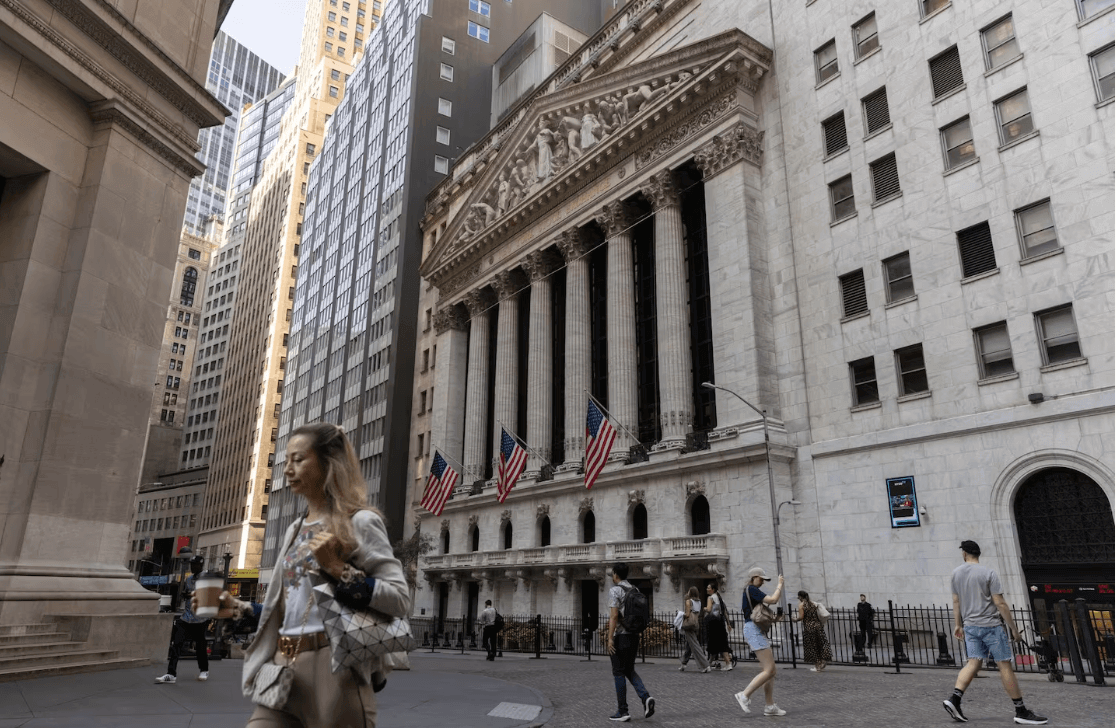8 月份通胀降温,美联储准备降息

【中美创新时报2024 年 9 月 12 日编译讯】(记者温友平编译)随着 8 月份通胀继续回落,美联储准备降低利率。《纽约时报》记者珍娜·史密亚莱克(Jeanna Smialek)对此作了下述报道。
8 月份通胀继续回落,为美联储在下周会议上自 2020 年初以来首次降息铺平了道路。
但顽固的迹象仍然存在,这导致投资者加大了对央行行长将借贷成本从目前的 5.33% 降低四分之一个百分点的押注,而不是一些人之前认为可能的半个百分点。
8 月份整体消费者价格指数较上年同期上涨 2.5%,通胀速度明显低于 7 月份的 2.9%,且较 2022 年 9.1% 的峰值大幅下降。
但周三引起华尔街关注的数字是每月的“核心”指标。该指标显示,在剔除食品和燃料价格(这两个价格都可能波动)后,7 月至 8 月期间价格上涨了多少。该指数小幅上涨至 0.3%,略高于经济学家的预期。

细节使得这一举措变得重要:这是因为房价的衡量指标出人意料地顽固。住房成本占整体通胀的很大一部分,因此如果住房成本没有像预期的那样降温,它们可能会阻止价格上涨速度完全回到美联储的目标水平。
不过,这种复杂情况不足以改变整体叙事。一段时间以来,通胀一直在逐渐放缓,为美联储改变政策立场铺平了道路,美联储官员试图在完全遏制物价快速上涨的同时,不让经济陷入困境,从而实现一种谨慎的平衡。
“我仍然认为,他们有足够的信心继续降息,但这也表明,降息的速度不能太快,”MacroPolicy Perspectives 高级经济学家兼创始合伙人 Laura Rosner-Warburton 表示。“我们还没有完全脱离困境。”
高利率就像踩在经济上的刹车。它们导致经济活动放缓,随着需求的减少,企业提高价格的难度也随之加大。但美联储官员希望谨慎行事。长期维持过高的利率可能会使经济放缓太多,刺激失业,并有引发经济衰退的风险。
如果物价上涨有可能得不到完全控制,美联储官员就不想过快降息太多,因为这样做可能会让经济重新升温,并使通胀成为一个持续存在的问题。但他们也不想拖延,以免危及劳动力市场的健康。
这可能会危及他们让经济平稳着陆的努力,也就是众所周知的“软着陆”。
专业服务公司毕马威 (KPMG) 首席经济学家黛安·斯旺克 (Diane Swonk) 表示:“软着陆既需要运气,也需要技巧,而运气的部分在于知道何时说‘我们完成了’并降息。”
这就是为什么官员们一直在密切关注即将到来的通胀和就业数据,考虑在下周三结束的为期两天的会议上以及未来几个月内如何快速采取行动。
政策制定者将在下周公布他们未来的计划,届时他们将发布新的季度经济预测。这些将概述未来利率的大致路径。
美联储下周的举措将标志着经济的一个转折点,这是迄今为止最明确的声明,表明央行行长们相信他们正在赢得抗通胀的战争,即使胜利尚未完成。
通胀在 2021 年初首次升温后,现在已经降温两年多了,终于接近正常水平。
美联储官员正式将通胀目标定为 2%,尽管他们使用个人消费支出价格指数来定义这一目标。该指标使用了周三消费者价格指数的部分数据,但发布时间较晚。通胀也在缓和。
罗斯纳-沃伯顿表示,她预计未来几个月住房成本将下降。但这一过程中可能会出现一些坎坷。例如,她预计二手车成本将在今年秋天回升。
正如 8 月份所表明的那样,有时一次性措施可以推高价格上涨。机票价格上涨有助于推高月度通胀。
“行进方向仍然很明确,”罗斯纳-沃伯顿说。“关键在于速度,以及它是否是线性的。”
报告发布后,股市下跌,表明投资者担心通胀可能会持续,并使迅速降息变得更加困难。
但即使这些细节令华尔街感到担忧,整体通胀率的持续降温可能对普通民众来说是个好消息。
随着物价上涨回归美联储的目标(无论多么坎坷),消费者可能会开始觉得自己正在迎头赶上。一年多来,工资增长速度一直快于物价上涨速度。
这对拜登政府来说是个好消息,因为物价上涨削弱了消费者信心,该政府一直难以将经济胜利(包括稳固的就业市场)归功于自己。
白宫国家经济委员会主席莱尔·布雷纳德在报告发布后的一份声明中表示:“随着通胀回落至接近正常水平,重要的是要集中精力维持我们在这次复苏期间为美国工人取得的历史性收益。”
本文最初发表于《纽约时报》。
题图:行人沿着纽约证券交易所附近的华尔街行走。随着 8 月份通胀继续回落,美联储准备降低利率。Jeenah Moon/Bloomberg
附原英文报道:
Inflation cooled in August, keeping the Fed poised to cut rates
By Jeanna Smialek New York Times,Updated September 11, 2024
Pedestrians walked along Wall Street near the New York Stock Exchange. As inflation continued to recede in August, the Fed is poised to lower interest rates.Jeenah Moon/Bloomberg
WASHINGTON — Inflation continued to recede in August, paving the way for the Federal Reserve to lower interest rates for the first time since early 2020 at their meeting next week.
But signs of stubbornness lingered under the surface, which caused investors to ramp up their bets that central bankers will lower borrowing costs by a quarter-point from their current 5.33 percent, not the larger half-point that some had previously seen as possible.
The overall consumer price index climbed 2.5 percent in August from a year earlier, a notably cooler pace of inflation than July’s 2.9 percent and down sharply from a peak of 9.1 percent back in 2022.
But the number that was getting attention from Wall Street on Wednesday was a monthly “core” measure. That gauge shows how much prices picked up between July and August after stripping out food and fuel prices, both of which can be volatile. And it ticked up to 0.3 percent, slightly more than economists had expected.
The details made that move important: It came as a measure of housing prices proved surprisingly stubborn. Shelter costs make up a big chunk of overall inflation, so if they are not cooling as expected, they could prevent the pace of price increases from returning fully to the Fed’s goal.
Still, that complication was not enough to change the overall narrative. Inflation has been gradually slowing for some time, paving the way for the Fed to shift its policy stance as officials try to strike a careful balance in which they fully defeat rapid price increases without tanking the economy in the process.
“I still think they are confident enough to proceed with rate cuts, but it suggests: Don’t go super fast here,” said Laura Rosner-Warburton, senior economist and founding partner at MacroPolicy Perspectives. “We’re not completely out of the woods.”
High interest rates work like brakes tapped on the economy. They cause economic activity to slow down, and as demand recedes, it becomes more difficult for businesses to raise prices. But Fed officials want to tread carefully. Keeping rates too high for too long could slow conditions down too much, spurring unemployment and risking a recession.
Fed officials don’t want to cut too much too quickly if there is a chance that price increases are not fully under control, because doing so could heat the economy back up and make inflation a persistent problem. But they also don’t want to drag their feet and risk the health of the labor market.
That could imperil their efforts to set the economy down gently, in what is widely known as a “soft landing.”
“Soft landings are as much about luck as skill, and the luck part is in knowing when to say ‘we’re done’ and cut,” said Diane Swonk, chief economist at the professional services company KPMG.
That is why officials have been closely watching incoming inflation and employment data as they contemplate how quickly to move, both at their two-day meeting that concludes next Wednesday and in the months to come.
Policy makers will lay out a snapshot of their plans for the future next week, when they are set to release fresh quarterly economic forecasts. Those will outline a rough path ahead for rates.
The Fed’s move next week will mark a turning point in the economy, providing the clearest statement yet that central bankers believe they are winning the war against inflation, even if the victory is not yet complete.
After first taking off in early 2021, inflation has now been cooling for more than two years, and it is at last approaching a normal pace.
Fed officials officially aim for 2 percent inflation, although they define that goal using the personal consumption expenditures price index. That measure uses some of the data from Wednesday’s consumer price index, but it comes out at more of a delay. It too has been moderating.
Rosner-Warburton said that she expects housing costs to fade in the months to come. But there could be bumps along the way. She expects used car costs to pick back up this fall, for instance.
As August illustrated, sometimes one-offs can lift price increases. A pop in airfares helped to push up monthly inflation.
“The direction of travel is still clear,” Rosner-Warburton said. “It’s about the speed, and whether it’s linear.”
Stocks sank after the report, in a sign that investors worried that inflation might linger and make it more difficult to cut rates quickly.
But even as the details worried Wall Street, the continued cooling in overall headline inflation could spell good news for Main Street.
As price increases return to the Fed’s goal — however bumpily — consumers may begin to feel like they are catching up. Wage growth has been faster than price increases for more than a year now by several measures.
That is good news for the Biden administration, which has struggled to take credit for its economic wins — including a solid job market — as rising prices undermined consumer confidence.
“With inflation coming back down close to normal levels, it is important to focus on sustaining the historic gains we have made for American workers during this recovery,” Lael Brainard, head of the White House National Economic Council, said in a statement following the report.
This article originally appeared in The New York Times.

